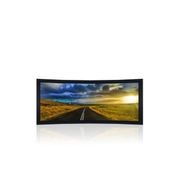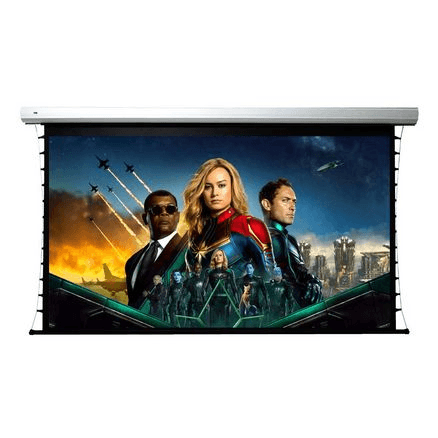140″ Indigo 2.35:1 Curved Cinemascope Acoustic Fixed Frame Screen 4k Ready
RapalloA curved screen design improves image depth and perception while increasing brightness uniformity, the way the roadshow cinemas do it.
Why might a curved projection screen better than a flat one? Despite its good looks, a curved projection screen plays a valuable role in today’s home theatres. Residential cinemas are more commonly featuring the same wide “Cinemascope” screen format as one would watch when actually at a top movie theatre. This wider format looks great but also creates problems that a curve screen design eliminates. The curve serves two purposes. First, it has an aesthetic appeal that draws in the viewer by enhancing a sense of immersion and depth while enhancing resolution and brightness.
The curved screen, together with the anamorphic process will increase brightness and enhance resolution by up to 30%. It does this by eliminating the black margins that can appear on the projection surface of flat cinemascope screens. Second, it eliminates a visual artifact known as “pincushion effect” which is encountered when scalers and anamorphic lenses are used to create a 2.35:1 (Cinemascope) format. Pincushion effect is when the top and bottom centre of a projected image appear to droop inward creating an hourglass-shaped picture. This happens because the light travels noticeably further to the edges of the screen than it does to the centre (The further the throw distance, the larger the image), creating unsightly black margins on the screen itself. The curve design ensures that light travels the same distance to reach any point of the screen thus creating a properly proportioned image. Because of the curvature of the screen, the light is now reflected back into the seating locations (not on to the walls) which increases foot lamberts to the seating locations and improves picture uniformity!
Indigo Moiré free acoustic transparent fabric, avoids the moiré problem completely by rotating the screen material so the perforated grid does not interfere with the projector pixel grid.
- CategoryTVs & Projectors
- RangeIndigo
- Weight: 35 kg
- Dimensions: 300 × 25 × 25 cm
Other products in this range
About the
Seller
Since 2005, Rapallo has been the friendly Kiwi company focusing on the sale and installation of quality Audio-Visual Products of the highest standards for a wide variety of budgets. We do what we do really well, to the point that we have become Auckland’s largest specialist AV Store (which we are very proud of) and most of our customers we almost know by name, as they come back time and time again.
Your “Rapallo” Experience:
We understand that your experience and your needs are unique. We believe it’s one customer, one experience at a time which is why we tailor our experience around you. In-depth information, the right advice, and always-available support are all here to make sure your needs are met. And because our customers actively promote our business to their friends and family, we instinctively understand that you are the most important aspect of our business.
We are, quite simply, awesome – but don’t take our word for it!
What makes Rapallo unique is the fact we’ve tailored our business to what our customers (yes we listen to you) want. We aim to provide you with all the assistance, advice and information you need to find a product that suits your budgets and needs. There are NO pushy sales techniques at Rapallo. For our team, it is about providing a solution that works with your vision, your budget and your requirements. We pay attention to every piece of customer feedback we receive and provide swift assistance where needed.
- ArchiPro Member since2021
- LocationView address
- More information












